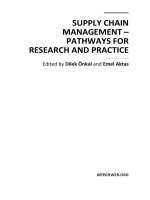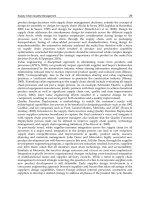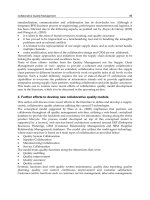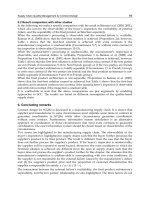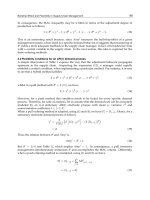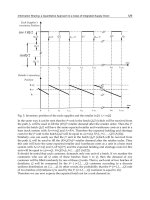Lean supply chain planning the new supply chain management paradigm for process industries to master todays vuca word
Bạn đang xem bản rút gọn của tài liệu. Xem và tải ngay bản đầy đủ của tài liệu tại đây (3.87 MB, 481 trang )
Tai Lieu Chat Luong
LEAN Supply Chain Planning
The New Supply Chain Management
Paradigm for Process Industries to
Master Today's VUCA World
This page intentionally left blank
LEAN Supply Chain Planning
The New Supply Chain Management
Paradigm for Process Industries to
Master Today's VUCA World
Josef Packowski
CRC Press
Taylor & Francis Group
6000 Broken Sound Parkway NW, Suite 300
Boca Raton, FL 33487-2742
© 2014 by Taylor & Francis Group, LLC
CRC Press is an imprint of Taylor & Francis Group, an Informa business
No claim to original U.S. Government works
Version Date: 20130830
International Standard Book Number-13: 978-1-4822-0534-3 (eBook - PDF)
This book contains information obtained from authentic and highly regarded sources. Reasonable efforts
have been made to publish reliable data and information, but the author and publisher cannot assume
responsibility for the validity of all materials or the consequences of their use. The authors and publishers
have attempted to trace the copyright holders of all material reproduced in this publication and apologize to
copyright holders if permission to publish in this form has not been obtained. If any copyright material has
not been acknowledged please write and let us know so we may rectify in any future reprint.
Except as permitted under U.S. Copyright Law, no part of this book may be reprinted, reproduced, transmitted, or utilized in any form by any electronic, mechanical, or other means, now known or hereafter invented,
including photocopying, microfilming, and recording, or in any information storage or retrieval system,
without written permission from the publishers.
For permission to photocopy or use material electronically from this work, please access www.copyright.
com ( or contact the Copyright Clearance Center, Inc. (CCC), 222 Rosewood
Drive, Danvers, MA 01923, 978-750-8400. CCC is a not-for-profit organization that provides licenses and
registration for a variety of users. For organizations that have been granted a photocopy license by the CCC,
a separate system of payment has been arranged.
Trademark Notice: Product or corporate names may be trademarks or registered trademarks, and are used
only for identification and explanation without intent to infringe.
Visit the Taylor & Francis Web site at
and the CRC Press Web site at
Thanks to all our customers for their
confidence and ongoing trust in working with us
as we strive to motivate them and encourage them to adopt
new ways to solve new challenges in business.
This page intentionally left blank
Contents
Introduction: What the Book Is All About........................................xvii
Reader’s Guide..................................................................................... xxv
About the Author and the Motivation for This Book................... xxxiii
Acknowledgments.......................................................................... xxxvii
Part I Why LEAN SCM Today?
Chapter 1 Supply Chain Management in Process Industries............ 3
1.1
Supply Chain Management Must Master
the VUCA World...............................................................5
1.1.1 Supply Chain Management Orchestrates
Global Functions and Networks........................5
1.1.2 Key Pain Points in Supply Chain
Organizations Today............................................6
1.1.3 Why Leadership is Concerned about
the Impact of Volatility........................................7
1.2 Supply Chain Planning in the VUCA World Today...... 8
1.2.1 Planning and Control as the Backbone
of Supply Chain Management............................9
1.2.2 The VUCA World Poses New Challenges
to Supply Chain Planning.................................11
1.2.3 Today’s Supply Chain Planning
Approaches and Their Limitations..................17
1.3 Why We Need a Paradigm Shift in Supply Chain
Planning Now...................................................................21
1.3.1 Traditional Planning Approaches Fail to
Deal with the VUCA World..............................22
1.3.2 Common Lean Approaches are
Insufficient for Global Supply Chain
Synchronization..................................................27
1.3.3 How to Back Out of the Dead End
of Today’s Planning............................................32
Chapter Summary......................................................................35
vii
Contents
Chapter 2 Guiding Principles of LEAN SCM Planning: Facing
VUCA Challenges............................................................. 37
2.1
LEAN Demand: How to Cope with Rising
Demand Variability.........................................................37
2.1.1 Accept Uncertainty and Eliminate the
Need for Certainty in Execution......................38
2.1.2 A View of Aggregated Demand: Be
Prepared for Consumption-Driven
Supply...................................................................39
2.1.3 Stop Using Forecasts to Trigger
Manufacturing: Respond to Real
Consumption......................................................41
2.2 LEAN Supply: How to Get a Grip on Supply
Uncertainty and Reliability........................................... 43
2.2.1 Manage Demand Spikes with Planned
and Right-Sized Safety Stock Buffers.............. 43
2.2.2 Level Production Plans to Create Flow
and Stabilize Utilization....................................45
2.2.3 Use Cyclic Production Patterns to
Achieve a Common Takt and Regularity...... 46
2.3 LEAN Synchronization: How to Master
Complexity and Ambiguity.......................................... 48
2.3.1 Separate Planning to Slice Complexity
for End-to-End Synchronization......................49
2.3.2 “Parameter-Driven” End-to-End Supply
Chain Planning...................................................50
2.3.3 Establish Visibility and a Collaborative
Environment for Synchronization...................51
Chapter Summary......................................................................53
Chapter 3 Fundamentals of LEAN SCM Planning: A
Paradigm Shift in Planning.............................................. 55
3.1
What Is the Most Suitable Supply Chain
Planning Approach to Follow?..................................... 56
3.1.1 The Lean Supply Chain is More about
Waste Elimination and Cost Efficiency.......... 56
3.1.2 The Agile Supply Chain is More about
Responsiveness and Customer Service............57
Contents
3.1.3 The Resilient Supply Chain Is More
about Risk- Avoidance and Robustness...........58
3.1.4 Trade-Offs among the Common
Paradigms in Supply Chain Management......59
3.1.5 How LEAN SCM Combines and Builds
upon a New Planning Paradigm......................61
3.2 The Building Blocks for LEAN SCM Planning:
Concepts and Highlights............................................... 66
3.2.1 Flexible Rhythm Wheels Enable Cyclic
Planning while Responding to Variability......67
3.2.2 Dynamic Safety Buffers in Planning for
Two-Sided Variability Management................71
3.2.3 Cycle Times and Inventory Targets
Aligned to Global Takt for Synchronization..73
3.2.4 Separation of Tactical PreParameterization and Planning to
Reduce Complexity............................................75
3.2.5 Enabling IT to Create Global Visibility
and Staying Power for Sustainability...............78
3.3 How LEAN SCM Planning Drives Corporate
Success in the VUCA World..........................................81
3.3.1 Creating a Step Change in Supply Chain
Performance........................................................81
3.3.2 Better Service Leads to Customer
Satisfaction and True Competitive
Advantages..........................................................82
3.3.3 World-Class Operational Supply Chain
Performance Means Financial Success........... 84
Chapter Summary......................................................................85
Part II How to Design and Build LEAN SCM
Chapter 4 Prepare Your Supply Chain for LEAN SCM................... 89
4.1
Segment and Strategize Your Supply Chain............... 90
4.1.1 How Many Supply Chain Strategies Are
Needed?............................................................... 90
4.1.2 Structure Customers and Products to
Build Supply Chain Segments...........................92
Contents
4.1.3 Assigning Strategies to Defined Supply
Chains..................................................................95
4.2 Aligning the Supply Chain from a TopDown Perspective........................................................... 99
4.2.1 Create End-to-End Transparency in
Supply Chains.................................................... 99
4.2.2 Identify and Assess Gaps to Improve
Supply Chain Synchronization.......................105
4.2.3 Adopt Three Measures for Preparing
the Supply Chain..............................................113
4.3 Aligning the Supply Chain from
a Bottom-Up Perspective............................................. 120
4.3.1 Gain Transparency into Local Value
Streams...............................................................121
4.3.2 Analyze Value Streams to Prepare the
Shop Floor for LEAN SCM............................ 123
4.3.3 Aim for Leveled Flow Design.........................130
Chapter Summary....................................................................137
Chapter 5 Strategic LEAN Supply Chain
Planning Configuration................................................. 139
5.1
5.2
5.3
What to Produce: Replenishment Modes...................141
5.1.1 Sell What You Make: Forecast-Based
Push Replenishment.........................................142
5.1.2 Make What You Sell: ConsumptionBased Pull Replenishment...............................143
How to Produce: Production Modes...........................150
5.2.1 Kanban and Its Advancements for
Process Industries.............................................150
5.2.2 Product Wheels and Rhythm Wheels for
Cyclic Production Planning........................... 154
5.2.3 How to Manage Variability with
Different Rhythm Wheel Types.....................158
Supply Chain Mode Selection: Combining
Production and Replenishment Modes......................167
5.3.1 Define the Configuration Scope of the
Supply Chain Segment.....................................168
Contents
5.3.2 Analyze Key Impact Dimensions
of Mode Selection.............................................170
5.3.3 Select the Appropriate Supply Chain
Modes.................................................................182
5.3.4 Evaluate Your Decision Quantitatively.........185
5.4 The Strategic Renewal Process to Configure
Agile Supply Chains......................................................188
5.4.1 What Information Base Is Needed on
Strategic Level?..................................................189
5.4.2 Establish Sustainable Renewal of Supply
Chain Modes.....................................................191
5.4.3 Ensure Supply Chain Agility through
Regular Mode Renewal....................................193
5.4.4 Who Is Involved to Enable Governance
for Supply Chain Agility?................................194
Chapter Summary....................................................................196
Chapter 6 Tactical LEAN Supply Chain Planning
Parameterization............................................................. 199
6.1
6.2
6.3
Setting Up the Parameters for LEAN
Production Modes.........................................................201
6.1.1 Classic Rhythm Wheel Design to Enable
Flow in Stable Environments......................... 203
6.1.2 Breathing Rhythm Wheel Design to
Manage Higher Demand Variability.............211
6.1.3 High-Mix Rhythm Wheel Design to
Manage Diverse Product Portfolios...............216
Setting Up the Parameters for LEAN
Replenishment Modes.................................................. 222
6.2.1 How Stocks Are Structured for
Variability and Uncertainty........................... 223
6.2.2 Right-Size the Parameters to
Enable Consumption-Based LEAN
Replenishment.................................................227
Synchronize Parameters to Achieve an End-toEnd LEAN Supply Chain............................................. 234
Contents
6.3.1 Synchronize Supply Chain Cycle Times
to a Global Takt................................................ 236
6.3.2 Build on Dynamic Inventory Target
Setting to Smooth Cycle Time Oscillation... 245
6.4 The Tactical Renewal Process to Parameterize
LEAN Supply Chains....................................................253
6.4.1 What Information Base You Need.................255
6.4.2 Establish Regular Renewal of Planning
Parameters........................................................ 256
6.4.3 Alignment of Planning Parameters for
the LEAN Supply Chain................................. 263
6.4.4 Who Is Involved in Keeping the Supply
Chain LEAN through Synchronized
Parameters?...................................................... 264
Chapter Summary................................................................... 267
Chapter 7 Operational LEAN Supply Chain Planning
Execution.. ...................................................................... 269
7.1
7.2
7.3
How to Execute Planning and Sequencing with
Rhythm Wheels.............................................................270
7.1.1 The Replenishment Trigger Report
as a Link between Production and
Replenishment..................................................271
7.1.2 Handling of Demand Signals with
Rhythm Wheels................................................274
How to Level Production with Factoring.................. 277
7.2.1 Use Cycle Time Boundaries to Stabilize
the Asset Takt................................................... 277
7.2.2 Use Upper Factoring When the Cycle
Becomes Too Long...........................................279
7.2.3 Use Lower Factoring When the Cycle
Becomes Too Short.......................................... 282
Effective Monitoring of Planning Execution in
LEAN SCM.................................................................... 284
7.3.1 What Should Be Monitored?.......................... 284
7.3.2 Operational LEAN Production KPIs to
Monitor Asset Performance........................... 286
Contents
7.3.3 Operational LEAN Replenishment KPIs
to Evaluate Inventory Parameterization...... 289
Chapter Summary................................................................... 292
Part III What to Implement and
Transform for LEAN SCM
Chapter 8 Build an Organization for LEAN SCM......................... 297
8.1
Below the Ground: The Prerequisites
for LEAN SCM.............................................................. 299
8.1.1 Management Buy-In and Mobilization
for LEAN SCM................................................. 300
8.1.2 Ensuring Leadership and Commitment
across Functional Borders.............................. 302
8.1.3 Shift in Mindsets and Accountabilities
in the SCM Community................................. 304
8.2 Above the Ground: The Visible Enablers
for LEAN SCM.............................................................. 307
8.2.1 What Is the Right SCM Organization
Model for LEAN SCM?................................... 307
8.2.2 Integration of LEAN SCM Processes
with the Existing Planning Processes
Framework.........................................................310
8.2.3 Mapping Roles and Responsibilities to
Renewal Processes............................................316
8.3 Managing Change and Transition for LEAN SCM.....319
8.3.1 Focus Areas of Change Management............319
8.3.2 Key Activities of Change Management.........321
8.3.3 Valuable Tools for Change Management
in LEAN SCM.................................................. 324
Chapter Summary....................................................................327
Chapter 9 Performance Management for LEAN SCM................... 329
9.1
Role of Performance Management in LEAN SCM..... 330
9.1.1 Key Objectives of Performance
Management for LEAN SCM.........................330
Contents
9.1.2 Orchestrating Supply Chain Planning
Processes Successfully......................................333
9.1.3 How the LEAN SCM Paradigm Changes
Your Performance Management....................335
9.2 How to Measure LEAN SCM Performance...............337
9.2.1 Metrics to Link Tactical and Operational
LEAN Supply Chain Planning.......................338
9.2.2 Metrics for Linking Strategic and
Tactical LEAN Supply Chain Planning.........339
9.2.3 Metrics for Assessing the Maturity of a
Supply Chain for LEAN SCM........................ 341
9.3 Five Points to Consider for Successful
Performance Management.......................................... 344
9.3.1 Develop a Balanced and Comprehensive
System of Metrics............................................ 344
9.3.2 Effective Target Definition for
Performance Tracking.................................... 345
9.3.3 Systematic and Regular Performance
Analysis for Sustainability............................. 347
9.3.4 Create Clear Responsibility for Metrics....... 348
9.3.5 Use Data Management and IT Systems
for Support........................................................ 349
Chapter Summary................................................................... 350
Chapter 10 The Planning System Landscape for LEAN SCM......... 353
10.1 The Evolution of IT Planning Systems....................... 354
10.1.1 MRP II: Consideration of Capacity but
Captured in the Automation Trap.................355
10.1.2 ERP: Functional Integration but Lost in
the Details......................................................... 356
10.1.3 APS: Supply Chain Integration but
Caught in the Optimization Trap..................357
10.1.4 The Forecast Myth: An Overarching
Obstacle..............................................................358
10.1.5 IT for LEAN Planning: How to Escape
the Optimization Trap and the Forecast
Myth...................................................................358
Contents
10.2 Enabling LEAN Planning: How to Leverage
Past IT Investments...................................................... 360
10.2.1 Enterprise Resource Planning........................361
10.2.2 Master Data Management.............................. 362
10.2.3 Market Demand Planning (APS Module)...... 362
10.2.4 Supply Network Planning (APS Module)....... 363
10.2.5 Detailed Planning and Scheduling
(APS Module)................................................... 363
10.3 LEAN Planning Add-Ons to Complete the IT
System............................................................................. 365
10.3.1 Configuring and Renewing Tactical
LEAN SCM Parameters.................................. 366
10.3.2 Planning and Adjusting Production
Based on Actual Consumption...................... 368
10.3.3 Performance Monitoring for the
Renewal Process................................................372
Chapter Summary....................................................................379
Chapter 11 The LEAN SCM Journey................................................ 381
11.1 Building Strong Commitment and Leadership
for LEAN SCM.............................................................. 382
11.2 Creating a Holistic LEAN SCM Architecture.......... 384
11.3 Establishing LEAN SCM Program Management.... 388
Chapter Summary................................................................... 390
Part IV How Your Industry Peers
Gained Benefits by LEAN SCM
Chapter 12 Read How Top-Industry Players Share Their
Experiences with LEAN SCM........................................ 393
12.1 Motivation and Approaches to LEAN SCM..............393
12.1.1 AstraZeneca’s Lean SCM Journey................. 394
12.1.2 Eli Lilly’s Synchronized Lean Production.... 400
12.1.3 Buffer Management at Novartis.................... 409
12.1.4 Leveled Flow Design to Enable LEAN
Planning.............................................................417
Contents
12.1.5 AstraZeneca Excellence with Rhythm
Wheel Takted Site............................................ 425
12.1.6 The LEAN Production Initiative at PCI:
A Company of BASF....................................... 432
12.2 Why LEAN SCM: Summary of Key Benefits........... 437
Bibliography......................................................................................... 439
Index..................................................................................................... 441
Introduction: What the Book
Is All About
Today, many global supply chains in process industries are neither
equipped nor orchestrated to cope effectively with the new VUCA world
we are facing. VUCA—volatility, uncertainty, complexity, and ambiguity—is an acronym that originated in the military back in the late 1990s
and was quickly adapted to the business environment. It describes precisely the conditions of increasing variability and uncertainty of demand,
and the complexity and ambiguity of product portfolios and supply chain
networks in which companies operate today.
Facing the threat of increasing VUCA challenges, manufacturers are left
grasping for what it means to build a superior supply chain management
(SCM) organization that is capable of managing these challenges effectively. Which enablers for agility are required to manage future VUCA
dynamics? Those in global network structures (the network footprint)
or others in the extended supplier relationship configuration (contract
manufacturers, service providers, or suppliers)? Which aspects of today’s
operational and organizational lean initiatives are delivering tangible cost
and efficiency results? How can supply chain organizations sustain reliable supply in an era of ever-widening virtualization of supply networks
and increasing exposure to global risk? Finally, where can supply chain
managers turn for the answers to these questions?
In response to these challenges, CAMELOT Consulting Group has
worked jointly with leading research institutes and key global industry
players to come up with a “New Supply Chain Planning Paradigm” to face
the VUCA challenges in SCM in a new way. The paradigm change in
orchestrating supply chains is best explained by laying out a new approach
to managing variability, uncertainty, and complexity in today’s planning
processes and systems.
A few pioneering supply chain organizations in the process industry
have already embraced the new way of coordinating and synchronizing
their global networks. The reports and industry cases included in this
book (see Figure 0.1).
xvii
Introduction: What the Book Is All About
Average improvement across all reported cases in this book
100%
–31%
100%
–35%
+4.4%
100%
–40%
93%
Variability
Inventory
Service level
Cycle time
Figure 0.1
A step change in variability management improves key supply chain metrics.
Before we move on to present this new supply chain planning approach,
we want you to clearly understand the need for a paradigm shift first. In
process industries, today’s usual supply chain planning practices aim to
determine manufacturing decisions up to 12 months prior to delivering
actual products to the customers. To do so, planners reach out to their
sales and marketing colleagues and ask them for forecasts—preferably as
detailed and accurate as possible at the SKU (stock-keeping unit) level. It is
obvious that the supply chain performance resulting from such a forecastbased SCM approach is directly linked to the quality of sales forecasts.
Therefore, it is understandable that all excellence initiatives in the past
have started inevitably by attempting to improve on forecast accuracy,
establishing the forecast myth that all activities could be perfectly planned
and which still dominates corporate practices. However, ask yourself if we
do not all experience difficulty in determining our own personal futures
12 months out, even regarding the subjects we ought to know most about.
How then can we expect our sales organizations to know what the future
holds for our products in volatile marketplaces at this detailed level of
granularity?
So the real issue in SCM is not about improving the accuracy of the sales
forecast and reducing the amount of uncertainty in the future, it is rather
about eliminating the need for certainty in operational planning. We have
therefore anchored our LEAN SCM Planning approach in freeing supply chain planners from the need for certainty, ushering in a paradigm
change for most planning practices.
Introduction: What the Book Is All About
A major change that accompanies our LEAN SCM Planning paradigm
is the management of demand variability. In traditional planning concepts, this is solved in a one-sided way, through planning and scheduling
of manufacturing capacities only. This is because in today’s supply chain
practices, and in the ERP or APS systems that support them, safety stock
levels are used as fixed planning parameters and not touched from a planning perspective to buffer variability. This has negative consequences for
operational performance and the way in which companies react to demand
fluctuations in planning. In this way, the traditional planning approaches
represent a conceptual dead-end for today’s variability management
problems.
Within the new LEAN SCM planning paradigm, we are mastering variability with a two-sided approach. We manage the demand variability in
supply chain planning now on both sides, on manufacturing capacities
and in inventories. To be more precise, the safety stock elements in all
SKU-based inventories are now actively used in planning runs, as they
have been designed for, to level replenishment signals and keep market
noise out of manufacturing to the extent possible. To make this happen,
we have developed a disciplined approach to the dynamic adaptation of
inventory target levels to changing conditions along the supply chain. This
allows SCM to keep a key component of demand variability—demand
peaks—out of manufacturing, smoothing capacity utilization, and spending less time resolving production planning and schedule problems. This
might sound intuitive, but represents a paradigm shift in the operation of
today’s planning processes and systems.
The conceptual foundation for managing variability and leveling capacity utilization in local manufacturing sites is the cyclic scheduling with
“product wheels.” Industry experts such as Ian F. Glenday, Peter L. King,
and Raymond C. Floyd have already been able to connect the general lean
(manufacturing) concepts, and the underlying elements of simplicity, flow
and pull, with physical restrictions that are typical in process industries.
These concepts have already been influential in many process manufacturing organizations. We have built on these experiences but needed to go
further to apply product wheels in a high-product-mix and high-volatility environment—which we named “Breathing” and “High-Mix” Rhythm
Wheels. They are built around optimal product sequences and cycle times.
But the most valuable conceptual advancement we have incorporated is
our approach to manage variability with two control parameters: the cycle
time boundaries. With these new conceptual elements, we are providing
Introduction: What the Book Is All About
appropriate flexibility in manufacturing to enable companies to manage
increasing market volatility, and we also hold the key for smoothing variability and volatility propagation upstream along the supply chain in our
hands.
The LEAN SCM planning concepts we present here have been worked
out in light of and for the purpose of end-to-end supply chain synchronization. So the central question is how to manage multi-echelon synchronization along supply chains in process industries, with typically long lead
times starting, for example, with chemical conversion processes and moving downstream to shorter physical bulk production and packaging processes? In particular, how should supply chain organizations apply cyclic
planning at manufacturing sites while aiming for real consumption-based
pull replenishment?
In response, we have formalized a “global takt” for synchronization and
achieving end-to-end flow. In a stable supply chain environment, this
might seem easy, but not in situations characterized by high demand
volatility and high product mixes in manufacturing portfolios. We have
to make the Rhythm Wheel approach more flexible, to “breathe” in sync
with cycle times, but in a well-structured, disciplined way, within the
defined variability control parameters. The key is to “funnel” variability
with the Rhythm Wheel cycle time boundaries along the supply chain
and in this way actively counteracting the infamous bullwhip effect and
achieve a step change in supply chain performance.
With traditional supply chain concepts, the line between planning
parameterization (configuration) and the planning run (execution) is
blurred. In contrast to this classical planning approach, in LEAN SCM
planning, we have sliced the given planning complexity precisely. We slice
the planning task horizontally into global tactical pre-parameterization
(conditioning) and local planning run areas. Having done so, we have
devised a new LEAN SCM Planning Framework to better cope with global
synchronization needs.
While working with industry pioneers on this new supply chain planning approach, we were confronted almost immediately with additional
questions when we stepped into the first implementations:
How should the organizational model be adapted to the significant
change in supply chain planning?
What are the new roles and responsibilities required in the global
supply chain community?
Introduction: What the Book Is All About
Which factors should be aligned in corporate performance management to the new planning principles?
What system gaps can be closed without discarding prior IT (information technology) investments?
How can this new planning paradigm be implemented to achieve a
step change in performance?
To answer these questions, we have consolidated all our conceptual
research results and organizational project experience in this book,
developed new IT add-on solutions to complement the existing SCM systems for implementation, and given a name to the holistic transformation approach—LEAN SCM. This new planning paradigm answers the
VUCA challenges in process industries and overcomes the insufficiencies
of traditional planning approaches. To highlight the distinction between
lean (in small letters)—with its focus on manufacturing objectives—and
LEAN—with its focus on end-to-end supply chain synchronization—we
coined the all-capitalized term “LEAN” (see Figure 0.2).
Our implementation experience shows that there are three major
obstacles to managing a LEAN SCM transformation program. First, a
company’s executive leadership must understand that this is not a singleproject initiative, but rather a journey—in other words, sticking to LEAN
SCM once the journey has started is crucial for success. Introducing
the new paradigm of integrated supply chain planning and variability
management requires a new SCM operating model with clear end-to-end
accountabilities. This will make end-to-end integration possible between,
for example, global inventory and local asset management. It is a new
way of coordinating and synchronizing operations and throughput in a
multi-step value chain. Top management support, training (and incentives) for all stakeholders, and strong commitment to the paradigm
change are the preconditions for successful transformation. But bear in
mind that you are aiming for nothing less than a step change in supply
chain performance.
Second, aligned performance management is a critical success factor in
the LEAN SCM transformation. The new conceptual elements and the
new planning processes require new process performance indicators, such
as Rhythm Wheel cycle time attainment and cycle time variation, to be
monitored carefully. Therefore, an effectively adapted and well-designed
performance management system is fundamental. But this typically does
not imply the need to reinvent current performance management systems.
=
≠
+
New planning paradigm
for end-to-end
supply chain management
Pre-parameterization
of supply chain parameters
(CT, IRL) reducing complexity
Synchronization
by variability “funneling”
across the e2e supply chain
+
+
Mastering variability
+ with adaptable cyclic planning
(rhythm wheel) for high-mix
+
Lean
(manufacturing) principles
Anchored in
Anchored in
+
+
+
Add-on IT applications
to implement LEAN SCM in
existing ERP/APS landscapes
Performance management
to adopt to new planning
methods and ensure reliability
Organizational alignment
in a new operating model to
enable global accountabilities
Transformation program
with a holistic approach and
a step change in performance
SCM
(supply chain management)
What lean SCM and LEAN SCM are about.
Figure 0.2
CT = cycle time, IRL = inventory replenishment level, ERP = enterprise resource planning, APS = advanced planning systems.
LEAN SCM
What LEAN SCM is about:
LEAN SCM
What LEAN SCM is not:
Introduction: What the Book Is All About
Introduction: What the Book Is All About
We will provide a set of meaningful metrics on the basis of which to generate improved supply chain performance through LEAN SCM. Finally,
we depict a pragmatic way of creating the right accountabilities within
performance management and show you how to anchor it in your planning organization.
Third, technology is instrumental in helping LEAN SCM create sustainable results. Many lean improvement initiatives depend on few
individuals and manual techniques—and if those individuals change
positions, much of the planning knowledge, enthusiasm, and leadership
are lost. In this light, IT applications are even more critical to capture
and standardize processes sustainably in a global end-to-end transformation. These additional IT technologies are also supposed to institutionalize LEAN SCM planning. Applications such as the “Rhythm
Wheel Designer” or the “Dynamic Target Stock Planner” provide interlocks with concepts such as cyclic planning and balanced variability
management in supply chain organizations, ensuring that common
LEAN SCM planning techniques and best practices have staying power
in your SCM organization.
You are holding the results of our LEAN SCM work in your hands right
now: it is a holistic practitioner’s guide to mastering variability, uncertainty, complexity, and ambiguity in process industry supply chains. It
also includes detailed concept descriptions and process explanations. To
make it even more practical and valuable for your own reflection, we
have enriched all topics with relevant industry cases. We believe that
the performance improvements achieved through LEAN SCM initiatives are best described by your industry pioneers themselves. You can
therefore also find in this book accounts of how your peers have already
lived the LEAN SCM paradigm, used the relevant instruments successfully, and gained:
Improved customer service and increased supply chain agility
through reduced cycle times for Rhythm Wheel-managed products.
Significant improvements in overall equipment effectiveness (OEE)
through leveled and takted material flows that are synchronized to
customer demand.
Significant reductions in working capital through actionable supply
chain analytics on variability and risk allocation of stocks across the
end-to-end supply network.
Introduction: What the Book Is All About
I am certain you will enjoy the same outstanding results along your
company’s supply chain by reading this book and adopting LEAN SCM—
because now you are targeting nothing less than a quantum leap in your
operations and supply chain performance.
Dr. Josef Packowski
Mannheim, Germany


